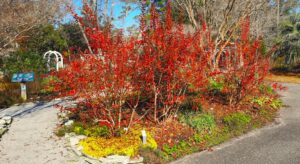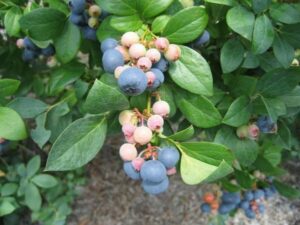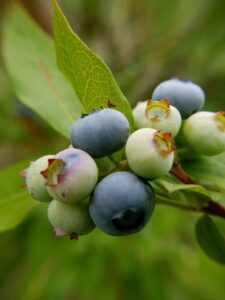Vaccinium for the Coastal Plain: ‘Rabbiteye’ and ‘Southern Highbush’
go.ncsu.edu/readext?1072756
en Español / em Português
El inglés es el idioma de control de esta página. En la medida en que haya algún conflicto entre la traducción al inglés y la traducción, el inglés prevalece.
Al hacer clic en el enlace de traducción se activa un servicio de traducción gratuito para convertir la página al español. Al igual que con cualquier traducción por Internet, la conversión no es sensible al contexto y puede que no traduzca el texto en su significado original. NC State Extension no garantiza la exactitud del texto traducido. Por favor, tenga en cuenta que algunas aplicaciones y/o servicios pueden no funcionar como se espera cuando se traducen.
Português
Inglês é o idioma de controle desta página. Na medida que haja algum conflito entre o texto original em Inglês e a tradução, o Inglês prevalece.
Ao clicar no link de tradução, um serviço gratuito de tradução será ativado para converter a página para o Português. Como em qualquer tradução pela internet, a conversão não é sensivel ao contexto e pode não ocorrer a tradução para o significado orginal. O serviço de Extensão da Carolina do Norte (NC State Extension) não garante a exatidão do texto traduzido. Por favor, observe que algumas funções ou serviços podem não funcionar como esperado após a tradução.
English
English is the controlling language of this page. To the extent there is any conflict between the English text and the translation, English controls.
Clicking on the translation link activates a free translation service to convert the page to Spanish. As with any Internet translation, the conversion is not context-sensitive and may not translate the text to its original meaning. NC State Extension does not guarantee the accuracy of the translated text. Please note that some applications and/or services may not function as expected when translated.
Collapse ▲Vaccinium for the Coastal Plain: ‘Rabbiteye’ and ‘Southern Highbush’
Article by Extension Master Gardener℠ volunteer Kathryn Copley
Blueberries are familiar as fruit-producing plants, but they may be less familiar as plants with landscape value — as accent or barrier plants or in a border or mass planting.
An important attribute is their attractive fall color, mostly deep reds but also some yellows. If fruiting is important, plant at least two different varieties for pollination and fruit set.
Within the genus Vaccinium, species vary in their ability to grow on different soil types as well as the time required to set fruit and their requirement for and tolerance of cold. For example, in the North Carolina Coastal Plain, cultivars with a chill requirement (time below 45◦) between 350 hours and 1,000 hours do best. ‘Rabbiteyes’ generally need 400 to 600 hours of winter chilling and a minimum temperature not below 5°F to 10°F.
Blueberries require soil that is highly organic and well-drained yet with good moisture retention. They require a lower soil pH than many other plants (between 4.0 and 5.0 or 5.5, depending on the cultivar), so take a soil test before planting them. Also, consider grouping them with other acid-loving plants such as hollies, azaleas and camellias.
For specifics on how to adjust pH, fertilize, prune, and in-crease yield, consult the NCSU Extension Gardener Hand-book.

Fall blueberry color in the Brunswick County North Carolina Cooperative Extension Service Botanical Garden Krys Ochota.
Flower buds formed the previous fall open in spring, and flowers are pollinated by both native insects (bumblebees, solitary bees) and honey bees. Berries develop and ripen 45 to 80 days after bloom, depending on the cultivar, and they ripen over a period of 3 to 5 weeks.
Two Vaccinium that are suitable for the North Carolina Coastal Plain are Vaccinium virgatum ‘Rabbiteye’ and Vaccinium formosum ‘Southern Highbush.’ They are relatively easy to grow when their site and soil requirements are met.
‘Southern Highbush’ blueberries grow 4- to 13-ft. tall and 3- to 10-ft. wide. Best fruiting occurs when situated in full sun. Because this plant tends to sucker, it can form small colonies. Like other blueberries, Southern Highbush blueberries attract pollinators and their edible fruit is a wildlife food source. Propagate by division, layering, seed, or stem cutting.
‘Rabbiteye’ blueberries get their name from the color of immature fruit; before they turn blue, the berries’ pink color is like the color of a white rabbit’s eye. They are known for their vigor and productivity, ripening later and over a longer period than highbush berries. The fruit has a slightly tougher skin and better storage life than highbush. ‘Rabbiteyes’ are more tolerant of drought, heat, and a wider range of soil types than high-bush. ‘Rabbiteye’ fruit continues to increase in size and flavor for some time after berries turn blue and appear to ripen. Allow the fruit to become fully ripe before picking (three to six days after turning blue).
Birds enjoy the fruit, so cover shrubs with netting as the fruit ripens.
These plants are frequently damaged by deer. Until recently, blueberries have not required insecticides or fungicides, but in 2009 the spotted-wing drosophila, a new and exotic fruit fly, became a problem. Some homeowner sites may also require fungicide sprays to manage mummy berry and other fungal diseases. For more information, see the NC State Blueberry Portal.
Resources
By Kathryn Copley, Extension Master Gardener SM Volunteer, Brunswick County, NC. For more information on gardening in Brunswick County, please call the Brunswick County Cooperative Extension Office 910-253-2610





